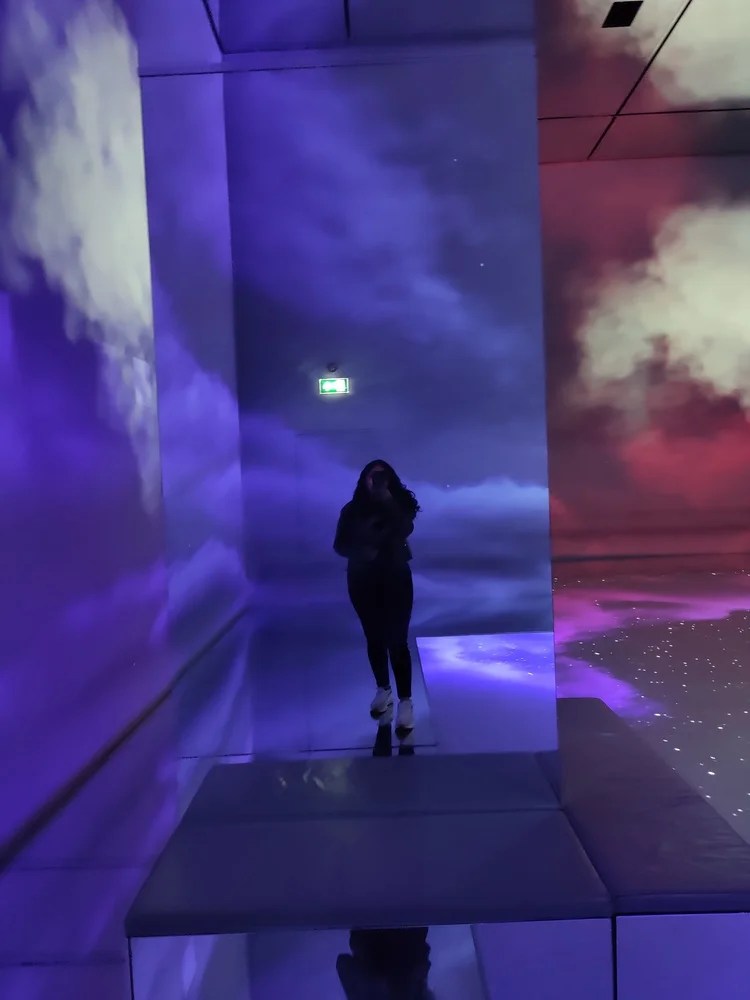What happens when Pink Floyd’s timeless music meets cutting-edge neuroscience and immersive art? At Brainstorms: A Great Gig in the Sky, this intriguing question found its answer in an event that seamlessly blended technology, creativity, and the human experience. As an EEG research assistant for this groundbreaking project, I had the privilege of being part of something truly extraordinary. Here’s a glimpse into my journey.
Setting the Stage: The Event

Hosted at the Frameless venue, Brainstorms was an 18+ immersive experience unlike anything I’d seen before. Visitors explored the impact of music on the brain through four reimagined galleries. Each featured sky-themed visualizations of how our minds respond to sound. From mesmerizing cloud formations to breathtaking auroras and swooping bird murmurs, the visuals complemented the iconic music of Pink Floyd and beyond.
The centerpiece of the event was Pink Floyd’s The Great Gig in the Sky. This track uses Clare Torry’s soaring vocals as an instrument rather than conventional lyrics. It was a fitting choice to explore how music stirs emotions deep within us.
My Role: Behind the Scenes with EEG Technology

As an EEG research assistant, my role was both technical and personal. I worked with VIP ticket holders who were curious enough to have their brain activity recorded while listening to music. They also wanted to see it transformed into stunning art.
Participants arrived at our station, where we set them up with the Emotiv Epoch X headset. This Bluetooth-enabled EEG device is almost dry, making it quick and comfortable to use. My team explained the process, answered questions, and prepared participants for what was about to unfold. It was fascinating to see the mix of excitement and curiosity as they settled in for their 10-minute brain scan session.



Once their data was captured, participants moved to the ‘Cloud’ gallery. There, they witnessed how their brainwaves interacted with the music. Seeing their brain’s response projected as mesmerizing visuals—flowing clouds, shifting hues, and subtle movements—was a moment of awe for many. For me, it was a reminder of how deeply music touches us in ways we’re only beginning to understand.
Insights: Neuroscience Meets Art




The brilliance of Brainstorms lay in its ability to transform raw brain data into something deeply human and accessible. The EEG recordings captured participants’ excitement, relaxation, stress, and engagement while listening to The Great Gig in the Sky. These responses were visualized in stunning ways, making the mind’s workings visible to everyone.
In the ‘Murmuration’ gallery, another highlight awaited: data from musician Imogen Heap and her young daughter. Their brainwaves were visualized as flocks of swirling birds. These mirrored how the same music can affect people differently yet beautifully. It was a poetic representation of connection and individuality—a mother and daughter’s shared yet unique experience of sound.
Memorable Moments
One of the most touching realizations during the event was how deeply people connected with the EEG setup and listening process. Initially, many of us—including the neuroscientists and artists—thought that the EEG setup was merely a step before experiencing the ‘Cloud’ gallery. However, as more participants came through, we realized that the setup itself was an intriguing and meaningful experience.
Fans of Pink Floyd from around the world came specifically for this event. I remember a devoted fan who traveled from Germany to London just to be part of this unique fusion of music, art, and neuroscience. They shared how much the band’s music had meant to them, making their brainwave visualization even more special.
We also welcomed people who had never heard the album or Pink Floyd’s music before. They were drawn by the promise of a one-of-a-kind immersive experience. Some participants came as groups of friends, eager to share in the excitement. Others were neuroscientists or academics curious about the intersection of their field with art and music.
The mix of visitors—from lifelong fans to curious newcomers and professionals in the field—created an environment of shared wonder. It was a privilege to be part of these moments, where the boundaries between science, music, and art dissolved, leaving only a profound connection to the experience.
A Learning Experience
This event was a treasure trove of learning for me. It was my first time working with a Bluetooth-enabled EEG headset. I gained invaluable hands-on experience with data collection in a fast-paced setting. Managing participants—many of whom had never encountered EEG technology—taught me the importance of clear communication and patience.
The collaboration was equally enriching. Working alongside brilliant minds from Pollen Music Group and Richard Wright Music, I saw firsthand how art, science, and technology can come together to create something magical. The entire process, from setup to execution, was a masterclass in teamwork.
Reflections and Gratitude
Being part of Brainstorms was more than just a professional milestone; it was a personal journey of discovery. Music has always been a powerful force in my life. Seeing how it resonated with others in such a visceral way was humbling. It also deepened my appreciation for the intersection of art and science and the potential it holds for future innovations.
Looking Ahead

Events like Brainstorms remind us of the boundless possibilities when creativity and technology collide. They inspire us to explore new ways of connecting with each other and understanding ourselves. I can’t wait to see how this project evolves and hope it sparks similar ventures worldwide.
To those who attended, worked behind the scenes, or are simply curious about the event—thank you for being part of this journey. And to anyone who hasn’t yet experienced the magic of music through the lens of neuroscience, I highly recommend seeking out opportunities like this. You might just find yourself in the great gig in the sky.
